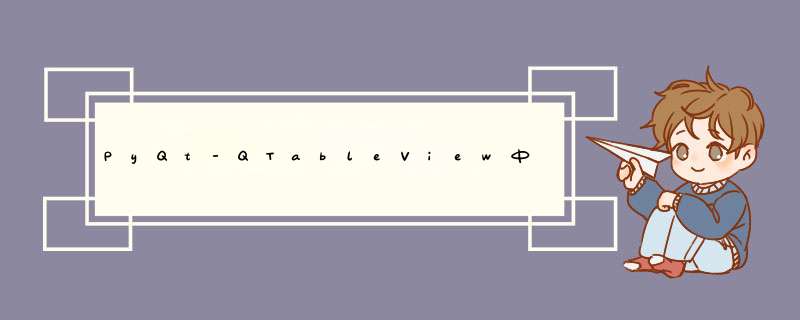
我为您找到了解决方案。诀窍是:
- 编写
setData
模型的方法 - 总是在
data
方法中返回QVariant
这里是。(我必须创建一个名为的类
Dataframe,以使示例在没有熊猫的情况下工作。请用您的所有
if has_pandas语句替换所有语句):
from PyQt4 import QtCore, QtGuihas_pandas = Falsetry: import pandas as pd has_pandas = Trueexcept: passclass TableModel(QtCore.QAbstractTableModel): def __init__(self, parent=None, *args): super(TableModel, self).__init__() self.datatable = None self.headerdata = None def update(self, dataIn): print 'Updating Model' self.datatable = dataIn print 'Datatable : {0}'.format(self.datatable) if has_pandas: headers = dataIn.columns.values else: headers = dataIn.columns header_items = [ str(field) for field in headers ] self.headerdata = header_items print 'Headers' print self.headerdata def rowCount(self, parent=QtCore.QModelIndex()): return len(self.datatable.index) def columnCount(self, parent=QtCore.QModelIndex()): if has_pandas: return len(self.datatable.columns.values) else: return len(self.datatable.columns) def data(self, index, role=QtCore.Qt.DisplayRole): if role == QtCore.Qt.DisplayRole: i = index.row() j = index.column() return QtCore.QVariant('{0}'.format(self.datatable.iget_value(i, j))) else: return QtCore.QVariant() def setData(self, index, value, role=QtCore.Qt.DisplayRole): if index.column() == 4: self.datatable.iset_value(index.row(), 4, value) return value return value def headerData(self, col, orientation, role): if orientation == QtCore.Qt.Horizontal and role == QtCore.Qt.DisplayRole: return '{0}'.format(self.headerdata[col]) def flags(self, index): if index.column() == 4: return QtCore.Qt.ItemIsEditable | QtCore.Qt.ItemIsEnabled else: return QtCore.Qt.ItemIsEnabledclass TableView(QtGui.QTableView): """ A simple table to demonstrate the QComboBox delegate. """ def __init__(self, *args, **kwargs): QtGui.QTableView.__init__(self, *args, **kwargs) self.setItemDelegateForColumn(4, CheckBoxDelegate(self))class CheckBoxDelegate(QtGui.QStyledItemDelegate): """ A delegate that places a fully functioning QCheckBox in every cell of the column to which it's applied """ def __init__(self, parent): QtGui.QItemDelegate.__init__(self, parent) def createEditor(self, parent, option, index): ''' important, otherwise an editor is created if the user clicks in this cell. ** Need to hook up a signal to the model ''' return None def paint(self, painter, option, index): ''' Paint a checkbox without the label. ''' checked = index.data().toBool() check_box_style_option = QtGui.QStyleOptionButton() if (index.flags() & QtCore.Qt.ItemIsEditable) > 0: check_box_style_option.state |= QtGui.QStyle.State_Enabled else: check_box_style_option.state |= QtGui.QStyle.State_Readonly if checked: check_box_style_option.state |= QtGui.QStyle.State_On else: check_box_style_option.state |= QtGui.QStyle.State_Off check_box_style_option.rect = self.getCheckBoxRect(option) # this will not run - hasFlag does not exist #if not index.model().hasFlag(index, QtCore.Qt.ItemIsEditable): #check_box_style_option.state |= QtGui.QStyle.State_Readonly check_box_style_option.state |= QtGui.QStyle.State_Enabled QtGui.QApplication.style().drawControl(QtGui.QStyle.CE_CheckBox, check_box_style_option, painter) def editorEvent(self, event, model, option, index): ''' Change the data in the model and the state of the checkbox if the user presses the left mousebutton or presses Key_Space or Key_Select and this cell is editable. Otherwise do nothing. ''' print 'Check Box editor Event detected : ' print event.type() if not (index.flags() & QtCore.Qt.ItemIsEditable) > 0: return False print 'Check Box editor Event detected : passed first check' # Do not change the checkbox-state if event.type() == QtCore.QEvent.MouseButtonPress: return False if event.type() == QtCore.QEvent.MouseButtonRelease or event.type() == QtCore.QEvent.MouseButtonDblClick: if event.button() != QtCore.Qt.LeftButton or not self.getCheckBoxRect(option).contains(event.pos()): return False if event.type() == QtCore.QEvent.MouseButtonDblClick: return True elif event.type() == QtCore.QEvent.KeyPress: if event.key() != QtCore.Qt.Key_Space and event.key() != QtCore.Qt.Key_Select: return False else: return False # Change the checkbox-state self.setModelData(None, model, index) return True def setModelData (self, editor, model, index): ''' The user wanted to change the old state in the opposite. ''' print 'SetModelData' newValue = not index.data().toBool() print 'New Value : {0}'.format(newValue) model.setData(index, newValue, QtCore.Qt.EditRole) def getCheckBoxRect(self, option): check_box_style_option = QtGui.QStyleOptionButton() check_box_rect = QtGui.QApplication.style().subElementRect(QtGui.QStyle.SE_CheckBoxIndicator, check_box_style_option, None) check_box_point = QtCore.QPoint (option.rect.x() + option.rect.width() / 2 - check_box_rect.width() / 2, option.rect.y() + option.rect.height() / 2 - check_box_rect.height() / 2) return QtCore.QRect(check_box_point, check_box_rect.size())###############################################################################################################################class Dataframe(dict): def __init__(self, columns, values): if len(values) != len(columns): raise Exception("Bad values") self.columns = columns self.values = values self.index = values[0] super(Dataframe, self).__init__(dict(zip(columns, values))) pass def iget_value(self, i, j): return(self.values[j][i]) def iset_value(self, i, j, value): self.values[j][i] = valueif __name__=="__main__": from sys import argv, exit class Widget(QtGui.QWidget): """ A simple test widget to contain and own the model and table. """ def __init__(self, parent=None): QtGui.QWidget.__init__(self, parent) l=QtGui.QVBoxLayout(self) cdf = self.get_data_frame() self._tm=TableModel(self) self._tm.update(cdf) self._tv=TableView(self) self._tv.setModel(self._tm) for row in range(0, self._tm.rowCount()): self._tv.openPersistentEditor(self._tm.index(row, 4)) self.setGeometry(300, 300, 550, 200) l.addWidget(self._tv) def get_data_frame(self): if has_pandas: df = pd.Dataframe({'Name':['a','b','c','d'], 'First':[2.3,5.4,3.1,7.7], 'Last':[23.4,11.2,65.3,88.8], 'Class':[1,1,2,1], 'Valid':[True, False, True, False]}) else: columns = ['Name', 'First', 'Last', 'Class', 'Valid'] values = [['a','b','c','d'], [2.3,5.4,3.1,7.7], [23.4,11.2,65.3,88.8], [1,1,2,1], [True, False, True, False]] df = Dataframe(columns, values) return df a=QtGui.QApplication(argv) w=Widget() w.show() w.raise_() exit(a.exec_())欢迎分享,转载请注明来源:内存溢出

 微信扫一扫
微信扫一扫
 支付宝扫一扫
支付宝扫一扫
评论列表(0条)